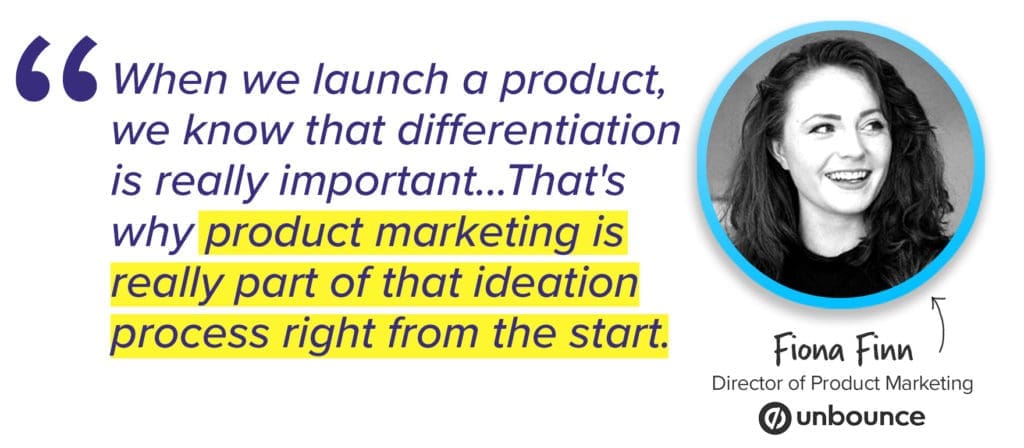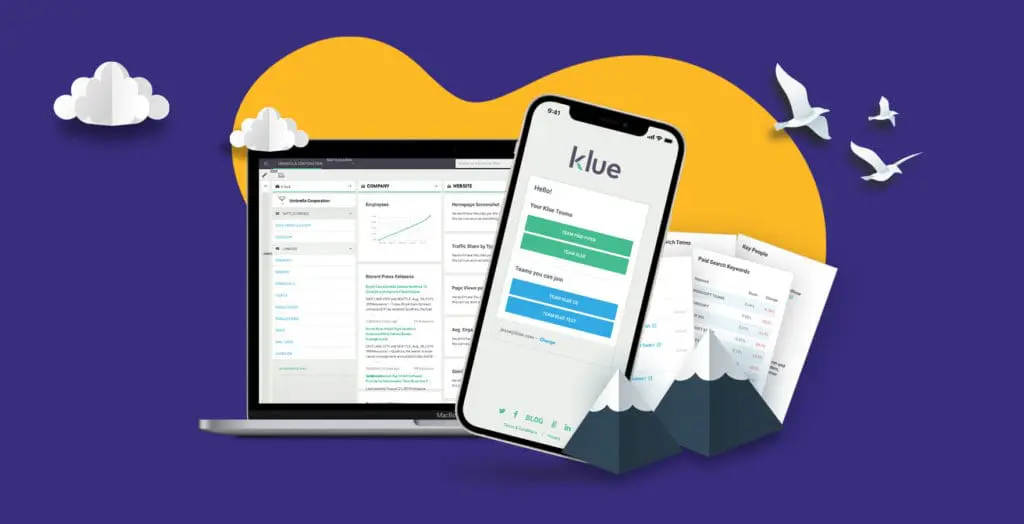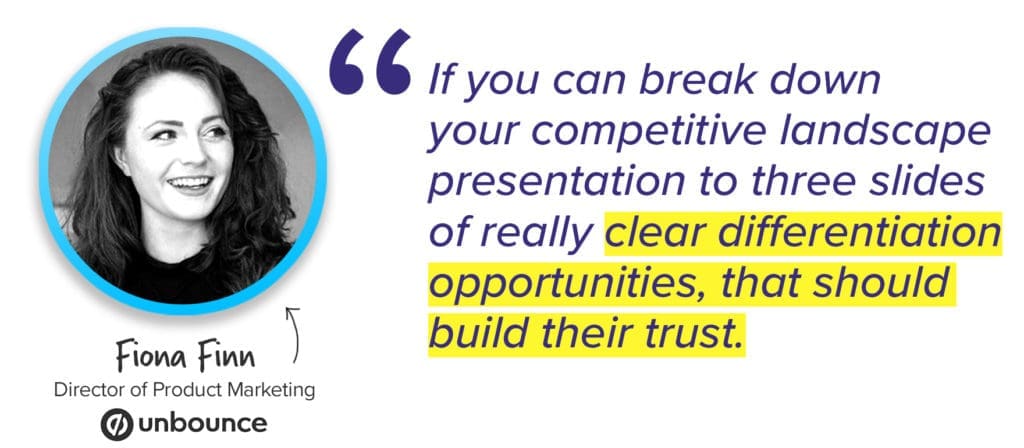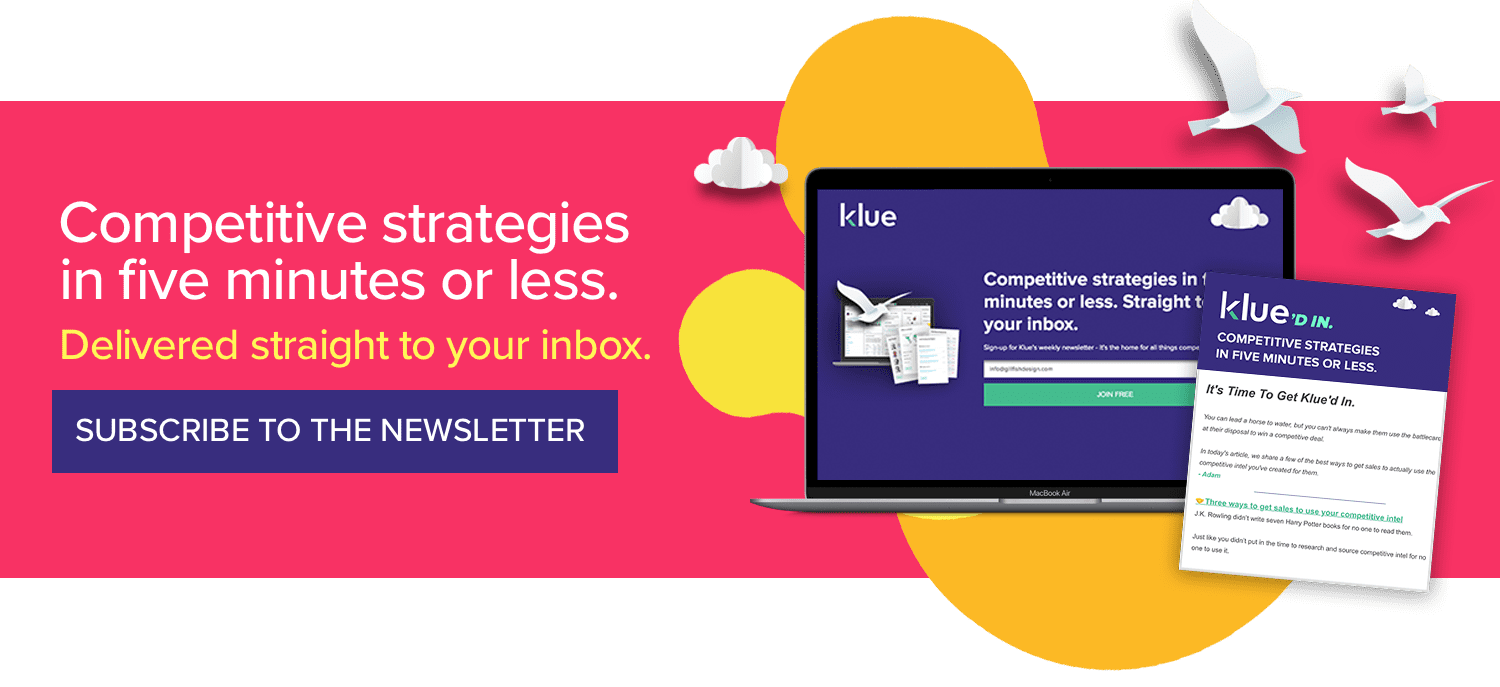Klue Compete
The Competitive Enablement Platform
Learn More
FIND OUT MORE >

Your sales team might be the most obvious consumer of competitive intelligence. But there’s also a hunger for competitive intelligence from product teams
But it can’t be the only team embedded in the world of competitive enablement. Not if your organization wants to win on every level.
For organizations like Unbounce, competitive intelligence is entwined throughout the organization — and a key driver of results across multiple departments.
So how did they get there? What drove Unbounce’s desire to leverage competitive intel to enable more than just the sales team? And what — or should we say who — ensures there is organizational visibility and leadership buy-in?
Listen to the full conversation with Fiona Finn, Director of Product Marketing at Unbounce on Spotify and Apple.
When Fiona Finn, Director of Product Marketing at Unbounce, first dove into the competitive enablement program at Unbounce, it wasn’t just sales that craved content. It turned out that Unbounce’s product team was the one with an appetite for competitive intelligence.
“I quickly did a bit of a search to see who are the most engaged viewers in the organization. I was so surprised to see that our product managers were way up there,” Fiona shared in a recent episode of the Competitive Enablement Show. “Of the seven most engaged individuals, I think five were within our product management team.”
Unbounce’s UX and product teams were already in the habit of checking out competitive battlecards in the discovery phase of a new product.
Fiona saw that product teams were looking for content on their competitors that would help them differentiate when launching a new feature or product.
She began to understand her product marketing team could support the product teams to help them start differentiating during the ideation and discovery phases.
“When we launch a product, we know that competitive differentiation is really important. There’s so many new technologies out there, both indirect and direct competitors. That’s why product marketing is really part of that ideation process right from the start. We don’t just come in at the end of the product life cycle when something is ready [to be launched]…We’re really embedded there at the start of the conversation.”


Fiona is constantly looking for ways to speed up the discovery process to bring products to market more efficiently. Using a Lean Canvas framework, with a section devoted to market landscape and competitive analysis, inputs from product marketing are used as a north star for how to differentiate.
“When reviewing the lean canvas in the direction you want to take, if there are things at odds between the market opportunity, competitive landscape analysis, and the solution you think you should be building… you have that data at an early point in time and you’re giving visibility to the product marketing sentiment and their competitive insights.”
There’s nothing worse than fumbling your differentiation strategy when you’re already 60-70% of the way through building a product. That’s why Fiona vowed to help the product team differentiate from the ground up.
Luckily for Fiona, there was already a competitive culture in place at Unbounce. However, in order for her competitive program to really be embedded within the organization, the competitive program had to:
The best way to help your cause is to get a quick win that can serve as a proof of concept of the entire program. And while all functions in an organization benefit from competitive enablement, a partnership with the sales team specifically is the gateway to success.


Read 5 reasons why your Competitive Enablement Program should support sales first
“I like to start on the ground by talking to people who are going to benefit most…make real connections and have some one-on-ones with trusted sales reps, people in revenue who look at churn metrics or win-loss every day and get a sense of where they need your help.”
Sales teams require hands-on tactical competitive support — you can showcase early tangible impacts of your competitive program by helping them close competitive deals.
In other words, your job is to figure out — and fill in — knowledge gaps preventing your sales team from closing deals. Gaps like:
An early partnership with sales will also allow you to collect competitive intel at scale. They hear things every day on calls in the field, and if you’ve built a strong rapport with them, they’ll be more likely to share back intel with you.
With sales and product bought into your program, you’ll be off to the races! Oh, except that you’re still missing buy-in from the most important group of stakeholders: the leadership team.
In a perfect world, your senior leadership team would intimately understand the value of your competitive program, and resource it accordingly.
In reality, it will take some serious proof, strategizing and persistence to not only get a seat at the table, but keep it as well.
With markets continually changing, Fiona and her team take every opportunity they can to get in front of leadership to present a competitive landscape ‘refresh’. Otherwise, the insights brought by her team risk becoming stale and obsolete.
“Intel can go stale, and we know that it’s so important for every company to stay ahead. Your position in the market should be changing all the time…competitors are changing. Your leadership team needs that information. So if you can set the expectation that you’re going to [regularly] deliver them with a completely fresh competitive landscape, they’ll wait for it and they’ll need it.”
Regular competitive landscape analysis can be provice key guidance to important business decisions each and every quarter.
A sure-fire way to make that happen is through having an understanding of the greater business strategy of the company. This helps you design a competitive program that aligns with your organization’s priorities.
“A really good exercise I’ve done a few times is to survey your leadership team on their top priorities in relation to the competitive landscape…and then with those findings, prioritizing your program to start checking off those priorities one by one. So that they are bought into it.”
With insights gathered from the team on the ground and your leadership team, you can start building trust with colleagues by providing something of tangible value.
In Fiona’s experience, a high-level, accompanying this updated competitive landscape analysis with three clear differentiation points is actionable and digestible.
“One thing I’ve found is that leadership loves really easy to consume matrix or landscape views of your position in the market…if you can break down your competitive landscape presentation to three slides of really clear differentiation opportunities, that should build their trust.”


As the competitive expert, once you provide this overview, the onus is on you to provide a handful of differentiation points applicable to each team within your organization. You’re tasked with the challenge of appealing to everyone, and not excluding anyone, in a clear and concise manner.
This involves considering the different priorities and styles of each member of the leadership team. What does the head of sales need to hear from you to prove your value? How does that differ from the CMO? Your CFO will always be thinking about revenue metrics, but not every CFO is the same.
“It’s kind of like the Spice Girls. Everyone has their very clear personality. They all have their own interests. So you have to decide what’s going to resonate most with each one. Make sure you’re including hard numbers and data…include your bits of product, include your sales processes, include your marketing message and differentiators…that should give them what they need to support their teams and have a clear idea of where you sit.”
Painting a clear picture of where your organization and your competitors stand, and how you can differentiate, might just be your best bet to getting the always buy-in from senior leaders.
To borrow a concept from Peter Thiel, going from zero to one is the biggest hurdle in building your competitive program from nothing to something.
For you and your competitive program to get there, you’ll need to:
A shared space like a Slack channel, bi-weekly updates via email, and regular meetings and presentations are all ways to ensure recognition the hard work you put into building the credibility of your competitive program.
With the right plan in place, it will never again be a question of if your organization should scale its competitive program across the organization. Instead, your problem will be how quickly you can expand your program into every department.
And that my friends, is a good problem to have.




Competitive Enablement
Product marketers conducting competitive research are drowning in reviews, reports, and messy notes. Here's how Klue's AI foundation will help you complete this analysis in seconds, not weeks.


Competitive Enablement
The topic of Large Language Models (LLMs) has a lot of confusion. Here's what you need to know about how Klue is working with them.


Let’s do it. Tell us a bit about yourself and we’ll set up a time to wow you.
Let's do it. Tell us a bit about yourself and we'll set up a time to wow you.
XLet's do it. Tell us a bit about yourself and we'll set up a time to wow you.
XSubscribe to get our latest AI functionality and news in your inbox.
XOur Buyer Pulse feature, set to launch in Q2 2024, offers valuable insights into the factors influencing buyer decisions in your pipeline. By signing up for the waitlist, we can better gauge interest and proactively engage with you to streamline the setup and integration process before the feature becomes widely available.
X